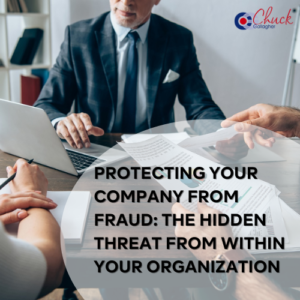 You put in countless hours as a business owner to ensure the continued prosperity of your firm. However, embezzlement and staff theft pose a hidden threat that could undermine your efforts. Think about the damage that could be done if a traitor were working within your ranks, stealing money and information without you knowing it was happening. Embezzlement is a white-collar crime that can affect any business, no matter how careful its owners are. The hidden threat within your organization is your people – sad to say.
You put in countless hours as a business owner to ensure the continued prosperity of your firm. However, embezzlement and staff theft pose a hidden threat that could undermine your efforts. Think about the damage that could be done if a traitor were working within your ranks, stealing money and information without you knowing it was happening. Embezzlement is a white-collar crime that can affect any business, no matter how careful its owners are. The hidden threat within your organization is your people – sad to say.
The Concealable Theft of Company Funds Is Embezzlement.
The abuse or theft of a company’s money or property, whether by an employee or the owner, is known as embezzlement. This dishonest behavior can surface in several crafty ways, costing the business much money. To safeguard your company from this peril, familiarity with the various methods of embezzlement is crucial.
Embezzlement: Common Cases of Theft by Employees
- Fraudulent staff can steal from the register by entering and collecting money for transactions, then voiding the sale and pocketing the funds without raising any red flags.
- There is a risk that a single worker counting cash donations at a fundraising event will keep some money for themselves.
- Employees can commit check cashing fraud by creating a sham business bank account, using it to accept customer payments, and then pocketing the difference.
- Dishonest workers may overcharge consumers or add made-up fees to invoices to pocket the extra cash.
- Employees with access to sensitive company data may fake payments to steal money.
- Some dishonest workers make up phony vendor accounts or tamper with accounting entries to avoid paying legitimate suppliers.
- Theft of Customer Credit Card Information: Employees with access to credit card information may utilize it for unauthorized personal purchases, damaging the company’s reputation.
- Employees can take advantage of expense accounts by charging duplicate purchases to their credit cards and then submitting those receipts for reimbursement.
- Employees may use their expense accounts for non-work-related expenses to seek financial support from their employers.
- Some workers may misuse employee discounts by sharing them with their personal networks.
- Employees trusted with cash may steal tiny sums over time, hoping to go undiscovered.
- Theft of office supplies can occur when workers take items for their use or sell them on the black market.
- Larger equipment, such as computers, can be taken from the office and used by dishonest workers.
- Embezzlement’s Widening Scope: New Cases to Keep an Eye On
- Corporate espionage (“selling trade secrets”) occurs when an employee sells confidential company information to a rival company.
- Workers with access to company credit cards will likely use them for personal purposes.
- Employees familiar with the building may commit burglaries there using their insider knowledge.
- Employees in the retail industry sometimes steal merchandise from the shelves or customers’ returns.
- Employees can file claims for lost or stolen equipment and receive equivalent but unnecessary replacements.
- Payroll workers can steal from their employers by creating ghost workers and having them work for them.
- Theft of Tax Money: Workers who process tax payments may pocket the money, putting the company at risk of legal action.
- Employees may accept kickbacks as payments from third-party vendors to secure commercial deals.
- Employee dishonesty can result in identity theft if dishonest workers open personal credit accounts or take out loans in the company’s name.
- Employees can use company assets to launch a side business if they see fit.
- Ponzi schemes are fraudulent financial schemes in which the schemers dupe investors into paying off existing investors with money from new investors.
- Employees may falsify business documents to conceal embezzlement or to mislead other stakeholders.
The Foundations for Safety and Prosperity
Your company’s reputation and bottom line are both at risk from embezzlement. Maintaining vigilance and initiative is essential in protecting your company’s assets. Combating embezzlement requires establishing reliable internal controls, performing periodic audits, and encouraging openness.
Strong deterrents can be created by educating workers on embezzlement penalties and building a culture of integrity. You can further bolster your defenses by using trustworthy accounting software, performing background checks, and protecting your digital data.
Setting clear standards, keeping track of inventory, and fostering oversight are all essential parts of a comprehensive strategy for preventing embezzlement. You may safeguard your company from the threat of embezzlement and assure its future growth and prosperity by following these steps. Remember that you are responsible for maintaining the safety and credibility of your firm.
If you have questions about how to protect your small business from unethical activities or fraud, feel free to reach out. Or, if you need a speaker at your event to discuss ways to protect your business from fraud, I’d love to talk.


